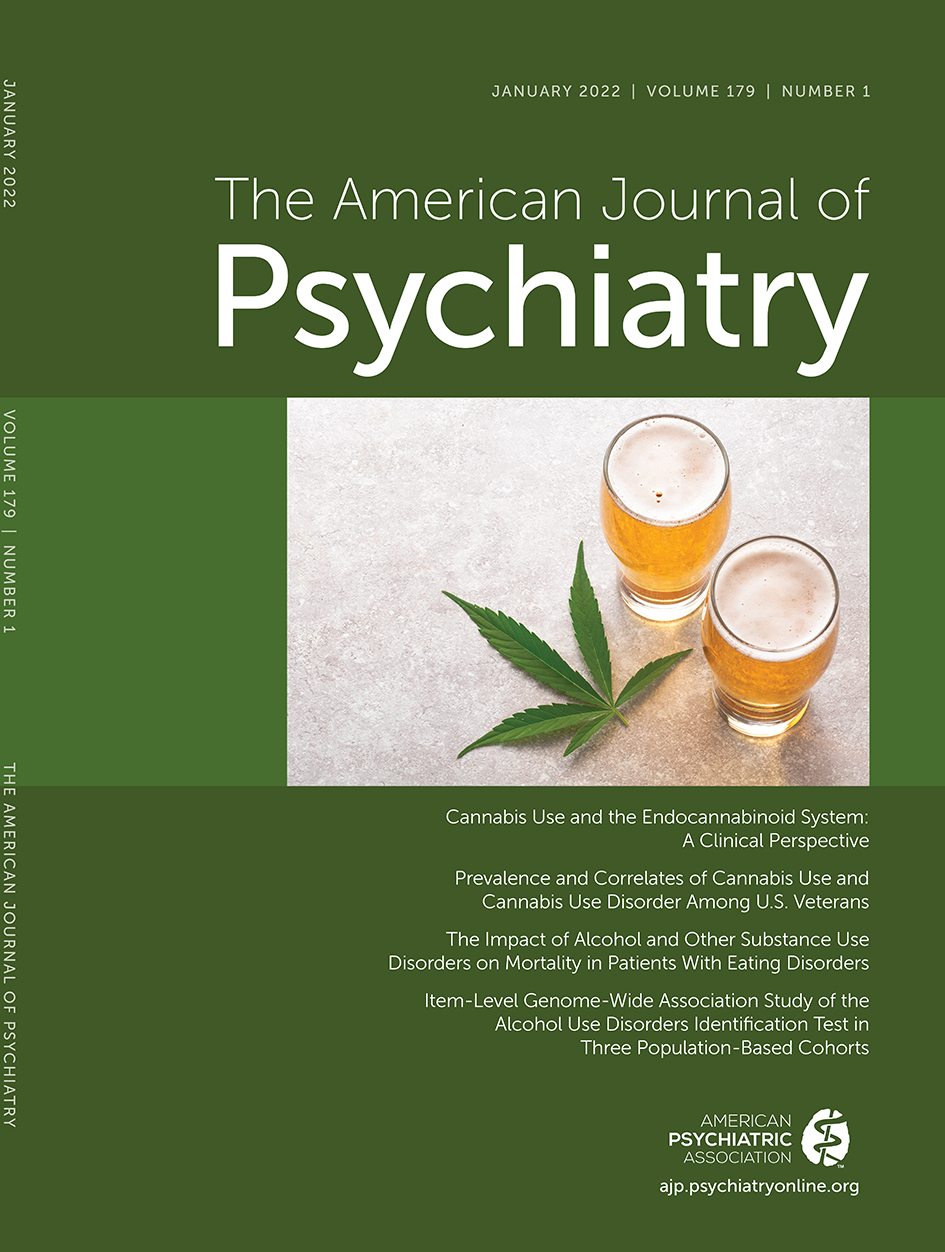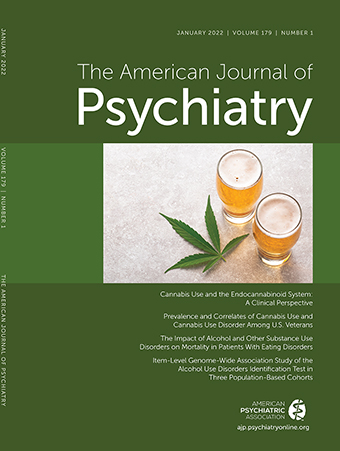Nonmedical (“recreational”) cannabis use and cannabis laws have changed over the past two decades in the United States (
1) and the rest of the world (
2). Increasing use, especially among the young, coupled with the increasing potency of cannabis (higher delta-9-tetrahydrocannabinol [THC] content) during this period (
3), has raised concerns about the long-term health impact of cannabis exposure, especially among adolescents and young adults. There is recognition of an association between cannabis use and psychosis, but whether the relationship is causal continues to be debated. One rebuttal raised in this debate is that if cannabis caused psychosis, then the increases in the rates of cannabis use should be accompanied by a parallel increase in the rates of psychosis.
The article by Livne et al. (
4) in this issue of the
Journal is the first report from a U.S. sample of an increase in the prevalence of self-reported psychotic disorders. The authors report an approximately 2.5-fold increase in the prevalence of self-reported psychosis when comparing nationally representative data from National Epidemiologic Survey on Alcohol and Related Conditions (NESARC) conducted in 2001–2002 (NESARC) and in 2012–2013 (NESARC-III) (
5). The question on self-reported psychosis, unlike those on self-reported
symptoms of psychosis, asks respondents whether they have been diagnosed with schizophrenia or a related psychotic disorder by a doctor or other health professional. The authors addressed dose-response by examining the relationship between proxy measures of dose (cannabis use frequency: any use, frequent use, daily use; and cannabis use disorder) and self-reported psychosis in NESARC and NESARC-III and any change in the magnitude of the relationship between the two surveys. They noted that compared with nonusers, those with any use and with cannabis use disorder were at increased risk of self-reported psychosis during NESARC. In comparison to NESARC, survey respondents in all four use categories were at higher risk of self-reported psychosis during NESARC-III. Lastly, no statistically significant differences were noted in the magnitudes of the estimates of relationships between the two waves of the survey.
Cannabis as a “Cause” of Psychosis: Epidemiological Studies
In the changing climate of cannabis liberalization, the findings of Livne et al. have considerable significance in informing public health policy and research. Furthermore, their findings in the U.S. population are consistent with other reports suggesting an increasing incidence of psychosis coinciding with the changing landscape of cannabis use (
6). A population registry-based report from Denmark previously noted increasing incidence of schizophrenia spectrum disorder between 2000 and 2012 (
7). More recently, Hjorthøj et al. (
8) demonstrated that the population-attributable risk fraction (PARF) for cannabis use disorder in schizophrenia increased from ∼2% prior to 1995 to ∼8% after 2010. This fourfold increase in the PARF paralleled the rising incidence of cannabis use disorder and the THC content of cannabis in Denmark during the same period. Collectively, these studies provide epidemiological evidence supporting an association between frequent cannabis use and psychosis outcomes. Complementing these findings, experimental studies have robustly demonstrated that THC can transiently induce clinically relevant acute schizophrenia-like sym-ptoms (
9).
Cannabis as a “Cause” of Psychosis: Human Genetic Studies
Emerging evidence from genome-wide association studies (GWASs) of schizophrenia and lifetime cannabis use have questioned a causal inference for the observed relationship between cannabis and psychosis. These studies, recently summarized by Gillespie and Kendler (
10), while acknowledging evidence for a bidirectional causal relationship between cannabis exposure and schizophrenia, suggest a greater role for “reverse-causal mechanisms” (where schizophrenia-related mechanisms lead to cannabis use) and “genetic confounding” (common underlying genetic risk for both schizophrenia and cannabis use), thus reinvigorating the long-standing debate on causality.
One approach to address the direction of causation that is less likely to be affected by confounding or reverse causation than conventional observational studies is bidirectional Mendelian randomization. In bidirectional Mendelian randomization, putative causal relationships between an exposure (cannabis) and an outcome (schizophrenia) can be tested through use of genetic variants associated with both the exposure (cannabis) and the outcome (schizophrenia) as instrumental variables. If cannabis truly causes the schizophrenia, genetic variants associated with the cannabis use will be associated with both cannabis use and schizophrenia, but the genetic variants associated with the schizophrenia will not be associated with cannabis use. The reverse will hold true if schizophrenia causes cannabis use. However, the bidirectional causal relationship noted in GWASs employing Mendelian randomization that suggest a larger effect for schizophrenia liability causing cannabis use have mostly focused on the phenotype of the presence or absence of any “lifetime cannabis use” and thus may ignore the contribution of recurrent and sustained cannabis exposure that usually precedes the onset of psychosis. Notably, a more recent multivariable Mendelian randomization analysis found a risk-increasing effect of cannabis use disorder on the liability for schizophrenia, even after accounting for smoking and lifetime cannabis use (
11). However, a latent causal variable analysis did not find a significant causal effect of cannabis use disorder on schizophrenia. The authors concluded that for the relationship between cannabis use disorder and schizophrenia, there is greater evidence for cannabis use disorder genetic risk variants contributing to schizophrenia risk via mechanisms independent of cannabis exposure (horizontal pleiotropy) rather than cannabis use disorder genetic risk variants contributing to schizophrenia exclusively via cannabis exposure (vertical pleiotropy) (
11).
Criterion-Based Model of Causation for Cannabis and Psychosis
Several decades ago, Sir Bradford Hill proposed several criteria to establish evidence of a causal relationship between a presumed cause and an observed effect (
12). The classic Hill criteria include strength of the association, consistency, specificity, temporality, biological gradient, plausibility, coherence, experiment, and analogy. The Hill criteria have formed the central tenets of causal inference in modern medicine and public health. We and others have attempted to frame the relationship between cannabis and schizophrenia using these criteria (
13,
14). A critical summary of the relevant recent literature from epidemiological, preclinical, and clinical studies that support or refute these criteria is presented in
Table 1.
In summary, much of the available evidence supports the criteria of strength, consistency, biological gradient, and temporality for cannabis causing psychosis. Furthermore, supporting specificity, while many substances are known to induce psychosis, the risk for conversion to schizophrenia is greatest with cannabis-induced psychosis. As noted earlier, there is robust experimental evidence from placebo-controlled studies that THC can induce transient psychotic symptoms. Lastly, some of the neurobiological markers of chronic cannabis exposure (e.g., P300, synaptic vesicle density) overlap with those seen in psychotic disorders, supporting biological plausibility and coherence.
Limitations of Criterion Approaches, Alternate Models of Causality
However, criterion-based approaches have been criticized for the lack of validity and utility in complex multicomponent causal systems (
15). While cannabis use may increase the risk for psychosis, its exposure is neither necessary nor sufficient for psychosis, suggesting that it is one of multiple causal components (
16,
17). Furthermore, the criterion of temporality fails to account for possible underlying reverse-causal or confounding effects of genetic risk that predates cannabis exposure. While these explanations do not by themselves disprove the hypothesis in the direction of cannabis use causing psychosis, they provide independent alternative “biologically plausible” and “coherent” explanations of the observed association. As noted in the summary of genetic evidence, it is likely that both genetic risk for psychosis and cannabis use act as component causes in the complex causal web underlying psychosis.
Alternative theories of causation in epidemiology and public health have favored a shift toward consequentialist models, which aim to identify causes that are actionable or modifiable (
18,
19). Causal inference of “counterfactuals” represents one such approach, which is based on imagining the consequences of changing the value of a single factor in a comprehensive causal system (
20). The counterfactual in this case would be that if cannabis exposure had not occurred, psychosis would not have occurred. These models allow estimation of the effects of manipulating a single variable, such as cannabis exposure, in a complex causal web of psychosis. Furthermore, these models can be applied to observational studies, making them particularly relevant to understanding the relationship between cannabis use and psychosis where experimental studies may not be feasible or ethical. The genetic risk for psychosis can be included in such a counterfactual model as a covariate.
The increase in the prevalence of psychosis reported in this issue by Livne et al., which parallels the liberalization of cannabis laws, offers potential opportunities to delineate the causal influence of cannabis on psychosis in a counterfactual or “potential outcomes” framework. It will be critical to follow the trend observed in the study in future waves of nationally representative surveys, to inform public health policy on the mental health impact of recreational cannabis consumption.

